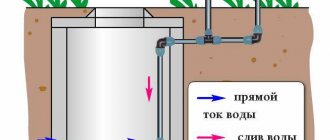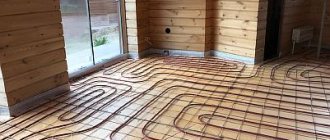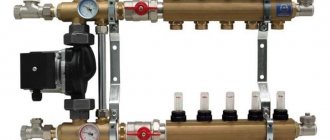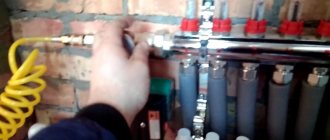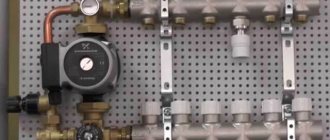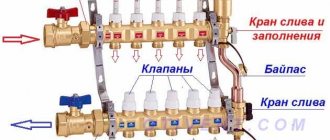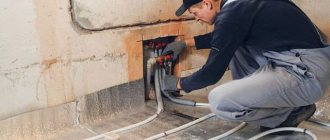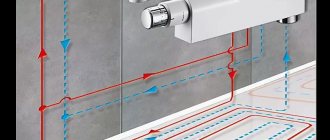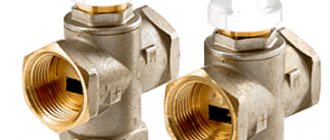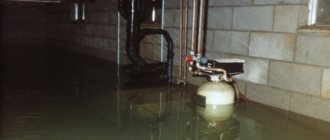When faced with repair work, going on a long trip or becoming a victim of an emergency, many people wonder whether it is necessary to drain the water from the heating system? In most cases, the answer is positive, although there are also situations where it is possible to fix a problem or make repairs with radiators filled with liquid.
Although the draining procedure is not particularly complicated, following the operating rules is an important nuance. If you violate the procedure, you can flood the floors in your own home with water. And if the drainage is carried out in a multi-story building, then neighbors may also suffer from incorrect actions.
How to drain a heating riser
1. Close the valves on the supply riser (1) and return riser (2).
2. Open the drain valves (3) and drain the coolant.
The second picture also shows a system with bottom feed. Only the supply and return risers are located in different rooms. Therefore, taps 1 and 2 can be spaced apart. And the procedure for draining the coolant is the same.
The third picture shows a system with top coolant supply. The supply line is located in the attic or under the ceiling of the upper floor.
Procedure for draining the heating riser:
- close valve 1 in the attic;
- find valve 2 in the basement and turn it off too;
- remove plug 3 and drain the coolant.
The same systems are made in multi-storey buildings.
It often becomes a necessary measure due to an emergency situation in the autonomous heating of the house or the departure of the owners for a long period of time in the winter. The question of how to do this was discussed in another article.
If you have a heating system with natural circulation installed (Fig. 1), you must immediately ensure that the boiler stops operating. Only after this can water be drained from the heating system.
. The discharge is made through a tap (valve), which should be located at the lowest point of the return line, usually next to the boiler. It is advisable to have a hose for this type of work. One end of the hose must be put on the tap, and the other end must be extended to the nearest place with soil, for example, a front garden, a vegetable garden, or, in extreme cases, drained into the sewer. After this, open the tap and wait until the hose stops flowing. It often happens that not everything has flowed out of the system; make sure that after removing the hose you can remove any remaining water.
Using the same method, you can discharge water from a heating system with forced circulation, which includes a pump that is not included in the boiler design. The reset procedure is the same.
Many modern systems are equipped with boilers that include a circulation pump (Fig. 2). The heating system installation method differs from the above, therefore, the supply and return pipes can be located above the baseboard or in the floor structure, just like the “warm floor” system.
1. First, turn off the boiler.
2. Place the hose on the tap from which water is drained from the heating system. It is advisable to put it on the return line (the right pipe coming from the boiler) to make a reset faster. If they are not under the boiler, find where they are. The other end of the hose can be directed into the sewer (a specially made outlet for drainage) or simply into a bucket.
3. Open the tap, wait until the water stops flowing (pressure drops) and turn off the tap.
4. Now we need to organize air access into the system. To do this, open the highest Mayevsky tap, usually installed on the heated towel rail (if equipped). If it is not available, on any radiator (for a two-story house, on the second floor).
5. Repeat the water draining procedure using the hose.
6. Now you can open all the remaining closed Mayevsky taps and repeat draining the water from the heating system again.
7. That's not all, now remove the hose from the return line and put it on the supply valve.
8. And reset again. The lower the hose is located along its entire length relative to the taps, the more water will drain from the heating.
Please note that water cannot be removed from the “warm floor” system in this way; a compressor or other equipment must be used.
Draining water from the heating system is not a quick procedure and requires some attention.
Water or coolant: choosing the optimal filling system
Antifreeze for the heating system
The optimal composition of the liquid should be determined by the parameters of the heating system. Often the heating system is filled with water, as it has a number of significant advantages. The determining factor is the affordable cost - they often use simple tap water. However, this is fundamentally wrong. A large number of metal elements and alkali will contribute to the formation of build-up on the inner walls of pipes and radiators. This leads to a decrease in the bore diameter and an increase in hydraulic losses in certain sections of the pipeline.
But how to properly fill a closed heating system with water to avoid such troubles? Experts recommend using distilled water. It is maximally purified from impurities, which has a positive effect on its physical and operational properties.
- Energy intensity. Water accumulates heat well in order to subsequently transfer it to the room;
- Minimum viscosity index. This is important for closed heating systems with forced circulation and affects the power of the centrifugal pump;
- As the pressure in the pipes increases, the boiling point shifts upward. Those. in fact, the process of transition from liquid to gaseous state occurs at a temperature of 110°C. This makes it possible to use high-temperature heating modes.
But if there is a possibility of exposure to negative temperatures, then water as a liquid for filling heating systems is unacceptable. In this case, you should use antifreezes with a crystallization threshold significantly lower than 0°C. The best option is solutions of propylene glycol or glycerin with special additives. They belong to the class of harmless substances and are used in the food industry. Solutions based on ethylene glycol have the best technical qualities. Until recently, they were used to fill closed heating systems. However, they are extremely harmful to humans. Therefore, despite all their positive qualities, the use of ethylene glycol-based antifreeze is not recommended.
But what can you fill the heating system with - water or antifreeze? If there is no chance of exposure to low temperatures, water is the best choice. Otherwise, it is recommended to use special coolant solutions.
Automotive antifreeze cannot be poured into the heating system. This will not only lead to boiler breakdown and failure of radiators, but will also be hazardous to health.
How to drain water from a water supply system
From time to time, it may be necessary to completely turn off all taps, fittings, sanitary equipment, or even drain water from the entire water supply network (for example, if the house remains unheated throughout the winter).
In this case, it is necessary to perform the following operations, which we present in technological sequence.
Draining. We turn off the water supply to the house. We disconnect gas and electricity from water heating systems. If you have central heating, you must open the outlet valve located on the boiler or on the pipes, for which you usually use a hose. Then you need to open all the valves on the radiators. Starting from the top floor of the house or mansion, open all the hot water taps in the shower, bath, etc. Don't forget to also drain the toilet tank.
We remind you once again: all water outlet taps on the heater and other equipment must be open. And lastly: it is necessary to open the outlet taps of the main water supply line so that all the remaining water leaves. If you leave your house or cottage for a long time in the winter, then take the time to make sure once again that all the water has left the system. As additional protection against frost, add salt or a glycerin tablet to the water remaining in the siphons. This will protect the siphons from possible rupture and eliminate the possibility of odors from the pipelines entering the room.
Rice. 1. 1 - compression plug; 2 - pin; 3 - threaded plug; 4 - nozzle
In the process of draining water from the system, it often becomes necessary to disconnect some of its sections. In this case, you need to use plugs. The most common plugs are shown in Figure 26.
Filling the system with water. The first step is to close the drain valves on the main pipes. Then you need to close all the taps in the house, including the boiler and water heater taps. If you have a cold water heater, you need to open the valve on the radiator and let air in. After all these manipulations, slowly open the main valve of the system and gradually fill the system with water.
Even before turning on the boiler, the batteries must be purged with air. At the final stage, turn on the gas and electricity to turn on the heater and boiler.
Measures to prevent water from freezing. There is a possibility of cold penetration from the street due to malfunctions in the heating system
In this case, it is very important to immediately take the necessary measures against freezing of pipes, since frozen water in them will immediately rupture the pipeline. In very cold weather, even those pipelines that were laid without violating the requirements can freeze, which often happens with pipes for supplying heat to a garage or basement.
What measures can be taken to prevent this? If the country house is electrified, in the cold area where the pipe runs, turn on an electric heater or simply place a 100-watt lamp near the pipe. For these purposes, you can even use a hair dryer to dry your hair. It is very good if you insulate the pipe before the onset of winter by wrapping it in newspapers and tying it with rope.
If the pipe is already frozen, wrap it in rags of any material and pour a thin stream of hot water so that the material around the pipe remains hot at all times.
A properly functioning heating system is an essential component of comfortable living in a house or apartment. Occasionally there is a need to replace radiators, fix leaks in the network, move or move the riser closer to the wall.
Any work on the system requires draining the coolant. And this is understandable. After all, it is impossible to open pipes when the network is full. Therefore, before starting repair and maintenance work, you need to drain the heating riser.
Heating filling quality control
Before filling a closed heating system with water, you need to make sure that all protective elements are present. These include Mayevsky taps, bypasses, and control devices - thermometers and pressure gauges. They are necessary not only to control the pressure in the pipes during the supply of coolant, but are also the main safety measures during heating operation. This is how you can properly fill a heating radiator with water.
When properly filling a closed system with water, the following parameters must be monitored:
- Pressure. Pressure gauges must be installed in key places in the system - the outer radiators and the highest point. After the final release of air, the pressure on all pressure gauges should be the same;
- No leaks.
This is the only way to achieve stable pressure. However, the main verification process occurs when the boiler is turned on. The thermal expansion of water at maximum operating mode should not affect the integrity of the pipelines of the heating elements.
Coolant replacement reasons and frequency
Replacing water in a closed and open heating circuit is carried out:
During the first heating start.
After installation, the system is filled and started
After seasonal drainage.
When starting after repair work.
Regular topping up of liquid is required during operation if it has not been drained after the heating season.
Why drain your home system?
A question for which there is no clear answer is whether it is necessary to drain the circuit annually after the end of the heating season? The decision depends on the type, age and material of manufacture of the main elements - pipes and radiators, as well as on the total volume of liquid.
Each type has its own frequency of media replacement
Most often, systems with old cast iron radiators are drained for the summer. The reason is the appearance of a leak after the boilers are turned off. The old cast iron ribs are connected to each other by threaded connections with old gaskets. When there is hot water inside the batteries, the seals expand, providing a stable seal at the seams.
After the water cools, the material from which the gaskets are made naturally contracts and begins to flow at the junction of the ribs. But prolonged idle time of old radiators without water is fraught with accelerated corrosion; the rust inside the radiator and old pipes crumbles in a dry environment, and can damage the entire riser.
In closed new circuits, filling the heating system is not a costly process. But it is not recommended to completely drain the liquid every year - this is not necessary.
Frequency of replacing and topping up fluid in the heating system
How often do you need to change the fluid in your heating system? A few general rules:
In open-type circuits of private houses, it is enough to simply add water if the system is sealed, without subjecting the old communications to stress tests in the form of long dry periods. Replacement is necessary only in case of emergency repair or preventive sealing, after washing.
If a leak occurs, it is necessary to drain the water and carry out repairs.
Closed heating systems require preventive flushing and replacement of the coolant after several years.
The frequency of filling with new liquid depends on the characteristics of the water, the service life of the synthetic coolant, and the general condition of the system. If the extreme points are very airy, it is recommended to identify the cause - find the location of the leak and check the tightness of the heating network. Typically, water changes are carried out every few seasons.
Draining glycol coolant
The main feature of antifreeze is the ability not to freeze at significant sub-zero temperatures. Antifreezes retain their properties down to -60 degrees, which makes their use justified in the conditions of our country. The exact freezing point varies and is directly related to the amount of water in the mixture. Manufacturers indicate optimal indicators on the labels. Most antifreezes are a water-glycol solution with a package of chemical additives. The use of these additives is necessary: the solutions themselves are quite aggressive and can react with pipes and other elements of the heating system. Additive packages help reduce the aggressiveness of alcohols and further stabilize the solution. However, these additives vary from manufacturer to manufacturer, and therefore it is not recommended to mix different types of coolants - this can lead to the formation of precipitation and increased aggressiveness of the solution. The coolant must be drained (regardless of the group) in the following cases:
- To eliminate leaks.
- Replacing radiators.
- Cleaning the system.
- Replacement.
Materials, equipment and procedure for draining water
To perform the necessary work, you will need a compressor, and of good performance, with a receiver for storing compressed air.
As you already understood, a car one is not suitable for these purposes.
If you are planning to drain used antifreeze, then you yourself understand that it is not worth draining it anywhere.
Clamps of the appropriate size for a reliable hose connection will also be needed.
Connect the hose from the compressor to the underfloor heating supply manifold.
The supply manifold may or may not have a special fitting in its design for filling the system under the hose. Therefore, the automatic air vent is unscrewed on the supply comb and a hose is connected through a suitable adapter and tightened with a clamp.
Arrangement of elements on the manifold for draining
- In the same way, connect the hose to the return manifold and lead it to the drainage point.
- Close the supply and return valves coming from the boiler in the manifold area.
- Using flow meters or valves (depending on your collector), close all underfloor heating circuits, except one, which, on the contrary, needs to be opened to the maximum.
- Turn on the compressor, open the valves or tap (depending on the type of comb) that are designed to fill and drain the system (those with hoses on them). At this moment, the coolant will begin to flow out of the drain hose under pressure. Wait until the water runs out and air comes out. At this point, pay attention to the pressure gauge on the compressor. If the pressure in the receiver at this moment is not high (1-3 atm), then close one of the taps on which the hose is attached (preferably, it would be a tap on the supply manifold, or if the pump is equipped with its own shut-off device, it is better to use it) . Wait for the pressure to rise to 5 atm. (no more) and blow out the floor loop under this pressure.
- Close the blown circuit and open the next one. Repeat the same procedure with him.
- In this way, drain the water from all underfloor heating circuits.
- For better efficiency, repeat the procedure after half an hour, since the remaining droplets of water in the pipe can connect with each other and eventually block the cross-section of the pipe in a certain place.
By following this method, you will solve the problem of how to drain water from a heated floor. The only problem is getting a compressor that can handle this task.
Self-pressure testing of underfloor heating systems
First launch of a warm water floor
Rules for installing a heated water floor based on a concrete screed
How to flush a heated floor heating system and how to completely flush the heating system in a private house with your own hands
Installation of water heated floors without concrete screed
Warm water floor system technology
Technical subtleties and nuances
In preparation for draining, it is necessary to study the structure of the collector in order to find and mark on the supply and return the location of the valves, marked as follows:
- servers are red;
- reverse flow - blue.
Connection diagram for a compressor for emptying the circuits of a heated floor system.
If you confuse the supply with the return, the drain system will not work - the check valve will block the pipeline.
If there is no receiving container, then you can connect the drain hose to the return valve and stretch it to the nearest sewerage intake - a toilet, sink or drain.
Collector unit for a warm water floor system
Having finished draining water from one circuit, empty all the others in the same way. When draining a section of the system, the valves of the remaining circuits must be closed, and at the end of each stage, the taps of the emptied pipelines must also be closed.
To completely empty the circuits, the purge procedure can be repeated after an hour - when the moisture from the walls of the heat pipes has drained and accumulated in some area.
Boilers
Residential premises are heated by a boiler with one or two circuits. In the second case, the owners also provide themselves with hot water.
Many heating devices also have internal cavities where the coolant reaches a given temperature. And after draining the liquid from the unit, its interior becomes free of water, and convenient conditions are created for working with all components and contacts.
The nuances of emptying boilers in the house were reflected above. But there are some more subtleties:
How to drain water from a double-circuit gas boiler correctly? This means emptying the heat exchanger. To do this, turn off the boiler and open the hot water tap until it cools down. After this, the flow of cold water is blocked. If necessary, all its contents are removed from the heat exchanger. Then the hot water supply fitting is unscrewed.
How to drain water from a modern wall-mounted gas boiler? Such devices have a drain fitting and an air vent. These elements work automatically. And to free such a boiler from liquid, simply open the drain valve after the preparatory stages.
Water draining technology, cleaning heating pipes
Drain valve in the heating system
Before filling the heating system of a double-circuit boiler, it is necessary to drain the old coolant. This procedure is mandatory and, despite its apparent simplicity, must be performed according to a certain technological scheme. First you need to turn off the heating and wait until the water temperature drops to room temperature. Only then can the closed heating system be properly filled with distilled water.
Then the drain valve located at the lowest point of the system opens. After waiting for the water to drain, you need to open the Mayevsky tap, which is located at the top point of the circuit. This is necessary to stabilize the pressure in the pipes. After completing this work, you need to flush the system. This is done before the heating system in a private home is filled. To do this, you need to use special tools and equipment. A pump is connected to the heating circuit, which pumps flushing liquid into the heating system. It also has a destructive effect on deposits in pipes. After several cycles of passage, contaminants are removed along with the liquid.
Used liquid must not be discharged into the sewer system. It must be collected in sealed containers, which are subsequently disposed of by special companies.
System design features
The design of the heating system in an apartment building is of two types: two-pipe and single-pipe. The single-pipe system has the main disadvantage of cooling the water on its way to the upper floors. Heat is directed from the bottom up under pressure, bypasses all thermal circuits and flows back through the same pipe.
In a two-pipe heating system, the coolant returns back through the second pipe, and the temperature is maintained high as it enters the system throughout its entire route.
Heating systems are also divided into open and closed. In an open system, water comes directly from the heating plant and is distributed through heating and hot water pipes. Most apartment buildings are built according to this type.
Prerequisites for draining water
This procedure is carried out in the following cases:
- Replacement of heating equipment.
- Correction of boiler malfunctions and repair of individual mechanisms.
- Elimination of leaks at valve contacts, fittings and other pipes.
- Turning off the heating for a long time in winter.
- Replacing the coolant.
It is also important to know when not to perform such a bowel movement. There are three situations here:
- The boiler is not threatened by cold. You need to leave a little water in it to protect the interior from rust.
- There was stagnant water in the device because it had been turned off for some time. Stale water is renewed. To do this, fill the tank full several times.
- The boiler is still under warranty.
The essence of the
The first step is to shut off the branch of the heating riser that goes to the apartment. It is enough just to close the distribution valve located here. For a private house with an autonomous heating system, this process is slightly different:
- firstly, you need to stop the supply of fuel or electrical energy;
- secondly, you should carefully read the user instructions for this case.
Only after this can the boiler be turned off. Then you should close the valve through which water is drawn into the system.
To speed up the process a little, you will need to know those places in the system where taps with air-type valves may be located. They all need to be opened. In this case, nothing will interfere with the flow of water to the hose.
During this operation, small leaks of water from the system onto the floor are possible. Therefore, at the very beginning, it is better to place a large bowl or basin under the place where the hose is connected to the tap (drain). As all the water leaves the system, it is necessary to disconnect the hose and drain the remaining water from it into a substitute container.
Only after completing all the described procedures can you move on to the main thing - to the work for which the water was drained from the heating system of a residential apartment or private housing construction.
If the owner of an apartment or house does not quite understand how to drain the water from the heating without harmful consequences, then it is better to contact a qualified contractor. For example, to a plumber from a company that services a specific home.
When winter weather sets in, around the end of October, it is imperative to drain all the water from the water supply system of the dacha. If the water is not drained, the system will fail, the taps will burst, and the storage water heater will simply burst.
In all of our plumbing installations, we provide two valves for draining water from indoor pipes, a drain valve on the water heater, and drain valves in the well or borehole.
It will take us a little time to drain the water:
3. Open taps 1,2,3,4 (see diagram below) - if they were closed for any reason and all taps (mixers) on all floors of the cottage or house, wait until all the water from the water supply drains into home.
4. Open the drain screw in the well to drain water from the main line. If you have a drain valve installed, the water will drain automatically when the pressure drops to 0.2 atm.
5. Unscrew the bottom part of the filter (such a transparent flask) after placing a basin or other container of at least 5 liters - it contains water!!! Discard the used internal filter. Install a new one next year. Do not screw the removed flask onto the filter for the winter!
6. To be safe, you need to drain the water from the sink siphon.
7. Don’t forget to drain the water from the toilet tank and the toilet itself.
Question to the expert: how to prepare your house for winter?
The family of our reader, Anna Balenkova, bought a country house in the spring. And they lived in it with pleasure all summer. But in winter they still prefer to live in the city. And so, at the end of the warm season, we asked ourselves: is it necessary to somehow specially prepare the house for wintering without the owners?
Private House : How to prepare a summer house for wintering?
Alexander Serykh, chief engineer of the heating systems department: Before leaving, it is necessary to close the ventilation holes so that birds or other animals do not get through them, and unscrew the electrical plugs. Insulate the windows and close them with shutters or board them up. Drinking wells are cleaned or sanitized. Particular attention should be paid to heating and hot/cold water supply systems: if antifreeze is used as a coolant - a non-freezing liquid that can withstand temperatures down to -40°C, frost will not affect the heating system in any way. If the coolant is water, it must be drained and the pipes must be blown out with an air compressor.
Also check that expansion tanks, water pipes, radiators and other tanks you have in your home have been drained. Don't forget about the bath, shower and toilet. Water in the sewer can only be removed from the tanks; it will remain in the lower part of the toilet or bidet.
To protect earthenware products from damage, fill them with antifreeze liquid, for example, concentrate for car glass.
Private House : What subtleties need to be taken into account when preparing the heating system for winter?
Alexander Serykh : Before draining the coolant, it is necessary to de-energize all installations: boilers, pumps, etc. They, as a rule, have their own drain valves, through which water should also be removed.
A heated floor system running in economy mode can maintain a positive temperature in the house, preventing complete defrosting.
As for the heating system, a drain valve must be provided at its lowest point through which the liquid is drained. To completely empty the system, it is necessary to open the air vents at the highest points and on the upper radiators.
It will be possible to drain the water only if the system pipelines have a slope towards the drain valve located at the lowest point, and there are no “bags”, that is, places where the pipe level decreases and then rises.
If any of the above conditions are violated, the water will not be completely removed. In this case, you can use a household air compressor. It is connected to the heating system (at the highest point) and, using air pressure, removes remaining water through the drain valve. Do not allow the pressure value to exceed P = 1–1.2 bar - the tightness of threaded or other connections of the system may be compromised!
If you choose antifreeze as a coolant, make sure that your pipes and radiators can withstand it.
The principle of removing water from the water supply system is the same. Be sure to open all the faucets on the upper floors, or better yet, all the faucets in the house to completely remove water from the pipes.
Now the only water left in the water heater is to drain it too:
2. During installation, we always install a drain tap (6) and a safety valve (5). If the drain valve (6) does not have a flexible connection (optional), install it. With a flexible hose, it is more convenient to drain water into a container located on the floor. The volume of water drained is equal to the volume of your water heater!
3. Wait until the water is completely drained from the water heater drain tap. Now some water remains in the safety valve (5). To drain water from the valve, turn the lever on the valve up. Note: On some valve models, the tab is held in place by a small screw. The screw must be unscrewed, the water drained and put back in place.
The process of preparing household appliances for the winter period
The boiler is disconnected from the power supply and the access to water is blocked.
After cooling, the water is removed from the device using a drain tap, and if it is not available, do this using a drain hose, having first unscrewed the screw on the safety valve. Then you need to loosen the nut on the outlet hose, which will allow air to enter and remove water from the boiler. Remaining water from dishwashers, as well as washing machines, is removed from the drain hole, most often located on the front panel at the bottom of the equipment. For this purpose, place a container under the drain, open it and remove the water.
How to drain water from a heating system
When is it necessary to drain water from the heating system? Most often, the need for it arises when it is necessary to clean or replace a heating radiator, for example. If we are talking about a city apartment that is connected to a central heating system, then such an operation can be carried out independently on the internal section of the network. In the event that it is necessary to drain the heating system of a private house equipped with a boiler, it will have to be temporarily emptied.
The essence of the
The first step is to shut off the branch of the heating riser that goes to the apartment. It is enough just to close the distribution valve located here. For a private house with an autonomous heating system, this process is slightly different:
- firstly, you need to stop the supply of fuel or electrical energy;
- secondly, you should carefully read the user instructions for this case.
Only after this can the boiler be turned off. Then you should close the valve through which water is drawn into the system.
Only after this can the boiler be turned off. Then you should close the valve through which water is drawn into the system.
To speed up the process a little, you will need to know those places in the system where taps with air-type valves may be located. They all need to be opened. In this case, nothing will interfere with the flow of water to the hose.
During this operation, small leaks of water from the system onto the floor are possible. Therefore, at the very beginning, it is better to place a large bowl or basin under the place where the hose is connected to the tap (drain). As all the water leaves the system, it is necessary to disconnect the hose and drain the remaining water from it into a substitute container.
Only after completing all the described procedures can you move on to the main thing - to the work for which the water was drained from the heating system of a residential apartment or private housing construction.
If the owner of an apartment or house does not quite understand how to drain the water from the heating without harmful consequences, then it is better to contact a qualified contractor. For example, to a plumber from a company that services a specific home.
Nature of the problem
The processes that occur with pipelines at the moment of freezing are quite complex, but we will try to explain them to you using simple examples. When you understand the reasons for breakouts in the spring, when everything thaws, you will understand how to protect yourself from such problems.
The main problem of any pipeline in winter is its carrier. Or rather, the media is not a problem when the system is operated as intended. We are, of course, talking about proper temperature control, normal pressure, etc.
However, in winter, at the same dachas, or in country houses where the owners are absent regularly, the temperature constantly drops.
You're not going to burn fuel to heat just the water supply. The temperature drop is constant, and in the coldest times of the year its level can drop to negative values.
What happens to the water supply system in this case? If it's dry, then nothing. The pipes don’t care what the temperature is outside or inside. Some types of plastic tolerate critical temperatures less well, but in the end no serious problems arise.
It’s a different matter when the pipes are not empty and there is carrier left in them. This could be water if we are talking about a water pipe, gas, etc.
A decrease in temperature also affects the condition of the carrier. At one point he will freeze. You probably know what happens to water when it freezes - it changes in volume. When defrosting, the reverse process occurs.
As a result, the greatest pressure is placed on the pipe material. Something must dampen the energy from the expansion of water.
In addition, the icing of water on the walls itself does not have the best effect on the structure of the water supply system. It is possible that microcracks, weakened areas, etc. may appear after several freezing cycles. Weaknesses will not make themselves felt immediately. But over time, you will definitely hear about them.
How to get rid of such problems? Yes, very simple. The water supply needs to be prepared before winter. Namely, use a compressor to blow through the pipes. The compressor will remove and completely clean the pipes of media, leaving behind a dry shell.
Where is purging used?
An equally important point concerns specific areas where a compressor as a blowing device is simply necessary.
The fact is that it’s not just the water supply that needs to be cleaned before winter. Quite the contrary, there are fewer questions about the water supply system, especially internal, that is, domestic.
Be that as it may, it is always warmer inside a room than outside; in order for the temperature inside to drop to negative values, a “wild frost” is needed. Although, this certainly happens.
A much more common case is damage to systems:
- external automatic watering;
- a water pipeline that runs along the street, for example, to neighboring houses;
- pipelines inside unheated premises;
- water supply supplying the pool;
- automatic animal feeders;
- for pumps and pumps.
All of them also need pre-purge with a compressor.
Some heating problems that do not require draining
Most often, heating problems are associated with the fact that water does not circulate in the heating system, for various reasons.
There are many reasons and the most common are:
Many disturbances in heating systems are interconnected, for example, water babbling in heating pipes. This phenomenon can cause discomfort and complaints - the heating radiators in the house make noise. Each person perceives the sounds that a heating system may produce differently. Some people think that the heating is humming, others perceive these sounds as humming. Unpleasant sounds include knocking on radiators during operation of the system.
Noises in heating circuits are phenomena of the same order and there are quite a lot of reasons that cause them:
The reasons listed are the most common.
In any case, if various unpleasant noises appear in the heating system that were not there before, you need to carefully inspect and analyze the operation of the circuit. Once the fault has been located, it must be eliminated.
But if you can’t find and fix the problem yourself, then you need to contact a specialist.
Category: Water supply and heating
Calculation of coolant volume
Residents of apartment buildings do not need to know about the volume of coolant in the system, but in private houses this knowledge is very important:
- Firstly, the expansion tank is selected depending on the volume of the heating system. Exceeding the required dimensions does not threaten anything special, but a tank that is too small will lead to constant overflow of coolant, and it will have to be topped up regularly.
- Secondly, in country houses it is very difficult to maintain a stable heating temperature, and when using solid fuel boilers it is impossible. It is impossible to leave the heating system in a full state during frosts, so the only solution to the problem will be non-freezing coolants. Since their cost directly depends on the volume of coolant, you also need to know the volume of the system.
There are two ways to determine the volume of the heating system without using complex calculation methods and regulatory documents:
- The first method is possible if, before refueling a closed-type heating system, a connection to the water supply is established through a jumper. A completely empty circuit (without coolant and air) is filled with water with the taps and valves closed. The amount of water spent on filling the heating system can be determined by a meter installed on the water supply system.
- The second method is to reset the system through the appropriate valve and place any container whose volume is known under the spilling water. When measuring the coolant volume in this way, you need to open the vents on each heating device so that water does not remain in them and lead to measurement errors.
How to drain water from radiators
Radiator
With the onset of October, the temperature, both outside and in apartments, gradually decreases. Each of us thinks: “the main thing is to hold out until the start of the heating season.” However, the situation does not change from year to year. The media announce that heating was turned on in houses on time and without delays, but many people’s radiators remain cold. It’s even more offensive when the heat still reaches the neighboring apartments, but not yours.
The reason for this unpleasant situation is the formation of air jams along the riser. These plugs clog the radiators on different floors of the building and lead to the fact that hot water, carrying the long-awaited warmth, cannot get through them. There are several ways to solve this problem, which I would like to consider below.
Options for solving the problem
The best option is to leave an application with the municipal unitary enterprise or homeowners association and wait for the mechanics. However, the wait may take up to several weeks. Many people want to resolve this issue as quickly as possible, so they independently manage the heat supply to the apartment.
Advantages and disadvantages of self-draining water
The main disadvantages include the following:
Damage to battery drain mechanisms
As a rule, any equipment tends to “age”, and those connected to water also become coked over time. If you open the battery drain mechanisms, let out the air and drain the water on your own, then you may not be able to close them. And this can lead to flooding of the neighbors, and, naturally, the heating will disappear in the entire entrance until the fault is eliminated.
Loss of water pressure in batteries
The main advantage of “cleaning” the radiators yourself is that heating is supplied to the apartment more quickly, because you don’t have to wait for the mechanics.
Work order
- It’s good if all batteries have a Mayevsky tap (valve) and two shut-off valves. Otherwise, you will have to invite locksmiths to avoid unpleasant consequences.
It is recommended to bleed air and drain water from the battery in the following sequence:
- Open battery shut-off valves. They are considered open when their handle is located along the pipes through which water flows in and out.
- Open the Mayevsky tap (valve), located in the top plug of the battery.
- Wait for water to flow through Mayevsky’s tap. Water will flow immediately after all the air has escaped through this valve.
- Drain the water until a smooth flow is achieved. When there are no more air bubbles left in it, this will indicate that the air lock has been eliminated.
- Close the Mayevsky valve.
- Adjust the shut-off valves to warm up the battery, providing the necessary heating to the room.
It should be noted:
It is recommended to drain the water from the battery yourself only if you are confident in the reliability of the equipment and in your own abilities. Otherwise, the water circulating in the heating system will only bring trouble. The safest option is to invite specialists from the service organization and transfer this “headache” onto their shoulders.
Compressors and their variants
Not all owners have the opportunity to use special equipment. In this case, purging is performed using a receiver and a car compressor. A hydraulic accumulator stabilizes the supply of liquid from taps and maintains internal water pressure in the water supply system up to 10 atm. It is used as follows:
- using an auto-compressor, air is gradually pumped into the membrane or bulb of the hydraulic tank;
- open absolutely all taps;
- supply air under pressure;
- The remaining water quickly pours out of the pipes.
To understand how to pump water out of a pipe, you need to know how different compressors work. The principle of their operation is based on various methods.
Piston compressor
Cylinders are used to compress air. The design of the device is extremely simple, it is accessible to every summer resident and can be easily repaired. But during use, the equipment produces a lot of noise, and it is unable to work for a long time.
Diaphragm compressor
Membrane technology works on the same principle as piston technology. But instead of metal working pistons, a thin membrane is used. This device is characterized by low productivity.
Screw compressor
Two screws rotate in opposite directions, forcing air into the chamber, from where it is fed into the hose. The advantage of such equipment: quiet operation, economical energy consumption. But this is expensive equipment that cannot be repaired on your own.
Scroll compressor
This is a small unit designed for use in confined spaces. Due to its low productivity, it is ineffective. Typically used when purging systems in the home.
How to properly drain water from the system
If a summer water supply system was installed on the site and the water rose from a shallow well or well, then in addition to draining the water from the internal distribution system in the house, it is necessary to remove the pump so that the water in the water supply pipe does not freeze. Such simple systems usually do not provide any specialized means for convenient draining. If water is supplied to the house from a well with a caisson, then there is no need to lift the pump from the well - just open the drain valve above the head and the water from the water supply system will return to the well. The drain valve is located between the check valve and the accumulator. During the process of draining water, all taps at water collection points must be open. If there is a storage tank in the house, drain the water from it. Don’t forget about the summer water supply located outside - it will suffer from frost before anyone else.
To carry out effective drainage, water pipes must have a certain slope so that all the water is guaranteed to leave the system and not linger somewhere inside. A small amount of water remaining in the pipe and turning into ice can rupture the pipe and break the seal. Even a strong steel pipe will not be able to withstand the pressure of the ice that forms. Water from the water heater is also drained through a drain valve connected to the tee. The tap and tee must have a hose attachment to the check valve on the incoming water heating pipe. Another tee with a tap must be installed on the outlet pipe from the heater to supply air when draining water.
If for some reason the drain taps were not installed when installing the water supply system, and frost is about to hit, then you can remove water from the pipes using a compressor. Getting into the pipes through the tee, compressed air is able to displace all the water out. The compressor can be used even with a drain valve if you want to purge the system and make sure that there is not a drop of water left in it. Air blowing is especially important if the internal water supply in the house is made of hard plastic pipes, which, for the sake of design, are mounted strictly horizontally. In this case, complete drainage from the system is obviously not guaranteed and the use of purging is mandatory.
If you live in a country house permanently, and the heating system uses ordinary water rather than antifreeze, then before leaving for a long time in winter, it will also have to be drained so that the heating pipes and radiators do not fail. Of course, for such cases, various complexity and price options have been developed for emergency heating of the water supply system, heating system, or the room as a whole to a temperature of several degrees above 0 C. But all these methods do not guarantee complete protection, because the boiler or other heat source is mainly controlled using electronics, and in your absence the electricity may be turned off. In addition, electric heating equipment constantly turned on in the absence of owners increases the risk of fire. Therefore, the best, cheapest and most reliable protection of the heating system from freezing is the use of antifreeze.
But if it happens that instead of antifreeze, water is used as a coolant, then how to properly drain this water from the heating system? Turn off the boiler or close the distribution valve on the pipe leading from the riser. Close the valve through which water is supplied to the heating system. To drain water from the radiator system, use a hose of the required length to divert the water to a discharge point into the sewer or into the street. Open the drain valve on the radiator, and in the heating system, open the faucet with the air valve - this will speed up the drainage of water.
Where else can water remain? Don't forget to drain the water from all siphons (hydraulic seals). There are water seals in every home; they are located in curved sections of the drain pipe under sinks, under bathtubs, and in toilets. Water also remains in the coarse filter, in the main filter unit, in the washing machine and dishwasher and in the electric water heater. Simply put, before closing your dacha for the winter season, check all the devices to which water was supplied in the summer.
All work on draining water and preserving the individual water supply system must be carried out at a temperature not lower than + 5 C.
Blowing pipes for the winter
One of the important elements in the garden is the water supply. Without watering, especially in dry summers, it is quite difficult to grow a good harvest. Mulch helps retain moisture in the soil, but this moisture must still be added to the soil. Therefore, periodic watering of plants is necessary. To organize irrigation in a garden plot, a water supply system of one of three types is made.
The first type of plumbing is its absence. Along the border of the garden plot there is a common water supply system, in which there is a tap for watering the plot. The advantage of such a system is that there are no pipes on the site and they do not interfere. The downside is that you need to carry a long, heavy hose from the tap, which damages the plants and destroys the beds.
The second type of water supply is above ground. The pipes are located on the surface of the garden plot. Plus - the system is easy to install, it is easy to drain water from it for the winter. The downside is that the pipes get in the way.
The third type of water supply is underground. The pipes are located underground at a depth of more than 30 cm.
Plus, the pipes don’t get in the way. Disadvantages - more labor-intensive and expensive construction of the system, the need to remove water for the winter.
Despite the disadvantages, underground water supply is more preferable for a garden plot, especially if landscaping is done on it.
Water can be supplied to each bed and the plants can be watered on them with a hose or a drip irrigation tape can be installed.
You can also place underground hidden water points on the site, covered with lids. We connect hoses or irrigation devices to the points during watering.
When installing underground water supply, it is optimal to use polypropylene pipes that are resistant to freezing in winter. That is, if water remains in them and turns into ice, then the pipe expands under the influence of ice. And when the ice melts in the spring, it narrows, but remains intact.
However, it is better to remove water from the pipes in the fall. If only for the reason that in the spring the ice in the pipe will not melt immediately and the pipes will not be able to be used at this time. For example, in 2014, the pipes thawed only on May 5th.
There are two ways to remove water from pipes.
The first is to lay the pipes at an angle when installing the water supply system and install a tap at the lowest point to drain the water in the fall.
The second is to blow air through the pipes. A household compressor will not work here, as it has weak outgoing air pressure. Over a long pipe length, the pressure decreases greatly and water is practically not blown out of it.
To ensure guaranteed water removal, you need to connect to the system with a pipe with a diameter of 12-34 inches and high air pressure. It's easy to do it yourself. You will need: a membrane expansion tank for the heating system, fittings, a compressor for the car, a piece of hose and clamps.
The essence of blowing pipes is as follows: we pump air into the expansion tank with a compressor, then we connect the tank with a hose to the water supply system and supply air from the tank into it. At the same time, water flies out noisily from open taps. Family members and neighbors within a radius of three hundred meters must be warned about this in advance.
The expansion tank is a metal container in which a membrane is located - a rubber container. When heated, water in the heating system expands and fills the membrane. The expansion of water is restrained by air pressure, which is pumped into the gap between the membrane and the tank body. Air is pumped through a valve at the end of the tank using a car compressor.
A membrane prevents us from using the tank to blow out pipes. We unscrew the tank flange, remove the membrane and screw the flange into place. Next, screw the tap onto the flange thread. If the thread is inch, then first install adapter 1-34.
Then the tap and place an adapter on it to connect the hose. We install the same adapter on any faucet of the water supply system. Next, we put a hose on the adapters and securely clamp them with clamps. It is important! When you open the tap, air under high pressure enters the hose, and if it is not secured, it can be torn off the adapter. And this is fraught with minor injury.
So, the hose was installed and securely fastened. Next, we connect a car compressor to the tank valve and pump air into it to a pressure of 6-8 bar.
Then we open the taps in the water supply system and open the tap on the tank. Air noisily enters the pipes and blows water out of them.
When organizing purge, you need to take into account that the longer the pipes in the system, the more air will be needed to purge them. The amount of air depends on the volume of the expansion tank. The larger the tank, the larger the system can be purged with it.
If you have a pipe 5-15 meters long, then a tank with a volume of 20-30 liters will be enough. Longer lengths will require tanks of 50-100 liters. Or you can use a smaller tank, but blow out the long system in parts.
In my opinion, it is better to immediately purchase an expansion tank of 80-100 liters and permanently install it somewhere in the workshop. You will have your own compressor station providing you with high pressure air. Moreover, an ordinary automobile pump will act as a compressor. You never know where you need high pressure air! Blow out the water from the pipes, blow out the air filter, etc.
